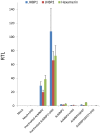Analysis of genes expression of Spodoptera exigua larvae upon AcMNPV infection
- PMID: 22860129
- PMCID: PMC3409162
- DOI: 10.1371/journal.pone.0042462
Analysis of genes expression of Spodoptera exigua larvae upon AcMNPV infection
Abstract
Background: The impact of Autographa californica multicapsid nucleopolyhedrovirus (AcMNPV) infection on host gene expression in Spodoptera exigua 4th instar larvae was investigated through the use of 454 sequencing-based RNA-seq of cDNA libraries developed from insects challenged with active AcMNPV or heat-inactivated AcMNPV.
Methodology/principal findings: By comparing the two cDNA libraries, we show that 201 host genes are significantly up-regulated and 234 genes are significantly down-regulated by active AcMNPV infection. Down-regulated host genes included genes encoding antimicrobial peptides, namely three gloverin isoforms and an attacin, indicating that the viral infection actively repressed the expression of a portion of the host immune gene repertoire. Another interesting group of down-regulated host genes included genes encoding two juvenile hormone binding proteins and a hexamerin, all of which are involved in juvenile hormone regulation. The expression of these genes was enhanced by the topical application of Juvenile Hormone III (JHIII) in the insects challenged with heat-inactivated AcMNPV. However, infection with the active virus strongly suppresses the expression of these three genes, regardless of the absence or presence of JHIII.
Conclusions/significance: Using RNA-seq, we have identified groups of immune-regulated and juvenile hormone-regulated genes that are suppressed by infection with active AcMNPV. This information and further studies on the regulation of host gene expression by AcMNPV will provide the tools needed to enhance the utility of the virus as an effective protein expression system and as an insecticide.
Conflict of interest statement
Figures







Similar articles
-
Comprehensive analysis of host gene expression in Autographa californica nucleopolyhedrovirus-infected Spodoptera frugiperda cells.Virology. 2011 Mar 30;412(1):167-78. doi: 10.1016/j.virol.2011.01.006. Epub 2011 Jan 28. Virology. 2011. PMID: 21276998 Free PMC article.
-
AcMNPV-miR-2 affects Autographa californica nucleopolyhedrovirus infection by regulating the expression of ac28 and several other viral early genes.J Virol. 2024 Aug 20;98(8):e0057024. doi: 10.1128/jvi.00570-24. Epub 2024 Jul 18. J Virol. 2024. PMID: 39023251 Free PMC article.
-
Functional regulation of microRNA-184 in the replication and infection of Autographa californica multiple nucleopolyhedrovirus.Pestic Biochem Physiol. 2024 Sep;204:106062. doi: 10.1016/j.pestbp.2024.106062. Epub 2024 Jul 30. Pestic Biochem Physiol. 2024. PMID: 39277376
-
Autographa californica nucleopolyhedrovirus infection of Spodoptera frugiperda cells: a global analysis of host gene regulation during infection, using a differential display approach.J Gen Virol. 2003 Nov;84(Pt 11):3029-3039. doi: 10.1099/vir.0.19270-0. J Gen Virol. 2003. PMID: 14573808
-
A proctolin-like peptide is regulated after baculovirus infection and mediates in caterpillar locomotion and digestion.Insect Sci. 2022 Feb;29(1):230-244. doi: 10.1111/1744-7917.12913. Epub 2021 Mar 29. Insect Sci. 2022. PMID: 33783135 Review.
Cited by
-
Increase in gut microbiota after immune suppression in baculovirus-infected larvae.PLoS Pathog. 2013;9(5):e1003379. doi: 10.1371/journal.ppat.1003379. Epub 2013 May 23. PLoS Pathog. 2013. PMID: 23717206 Free PMC article.
-
Microbial acetylcholinesterase inhibitors for Alzheimer's therapy: recent trends on extraction, detection, irradiation-assisted production improvement and nano-structured drug delivery.Appl Microbiol Biotechnol. 2020 Jun;104(11):4717-4735. doi: 10.1007/s00253-020-10560-9. Epub 2020 Apr 13. Appl Microbiol Biotechnol. 2020. PMID: 32285176 Free PMC article. Review.
-
Strategies and molecular tools to fight antimicrobial resistance: resistome, transcriptome, and antimicrobial peptides.Front Microbiol. 2013 Dec 31;4:412. doi: 10.3389/fmicb.2013.00412. Front Microbiol. 2013. PMID: 24427156 Free PMC article. Review.
-
MicroRNA-Mediated Host Immune Genes Manipulation Benefits AcMNPV Proliferation in Spodoptera frugiperda.J Agric Food Chem. 2023 Nov 2;71(45):17175-87. doi: 10.1021/acs.jafc.3c05012. Online ahead of print. J Agric Food Chem. 2023. PMID: 37917564 Free PMC article.
-
Gut Transcription in Helicoverpa zea is Dynamically Altered in Response to Baculovirus Infection.Insects. 2013 Sep 23;4(3):506-20. doi: 10.3390/insects4030506. Insects. 2013. PMID: 26462433 Free PMC article.
References
-
- Guo T, Wang S, Guo X, Lu C (2005) Productive infection of Autographa californica nucleopolyhedrovirus in silkworm Bombyx mori strain Haoyue due to the absence of a host antiviral factor. Virology 341: 231–237. - PubMed
-
- Pearson MN, Russell RL, Rohrmann GF (2001) Characterization of a baculovirus-encoded protein that is associated with infected-cell membranes and budded virions. Virology 291: 22–31. - PubMed
-
- Summers MD (2006) Milestones leading to the genetic engineering of baculoviruses as expression vector systems and viral pesticides. Adv Virus Res 68: 3–73. - PubMed
-
- Bangels E, Gobin B (2008) Efficacy results of insecticides against Cydia pomonella, the codling moth, in Belgium during the last decade (1998–2007). Commun Agric Appl Biol Sci 73: 655–658. - PubMed
-
- Moscardi F (1999) Assessment of the application of baculoviruses for control of Lepidoptera. Annu Rev Entomol 44: 257–289. - PubMed
Publication types
MeSH terms
Substances
LinkOut - more resources
Full Text Sources

